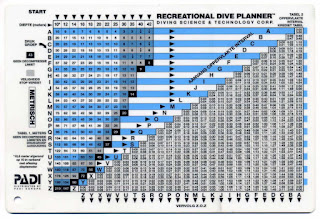Throughout the history of diving, decompression limits have been calculated using standard No Decompression Limit (NDL) Tables, the first of which were developed in 1908 by John Haldane after several experiments exposing goats to pressure. Since then, tables have been re-developed and re-defined to provide a model for safety limits within diving based on depth and time. There are several different variations based on different decompression research, however recreationally we typically use the quite conservative Recreational Dive Planner (RDP).
NDL Tables act as a mathematical model to predict how much nitrogen our bodies will absorb during a dive based on maximum depth and bottom time. Providing we stay within the parameters of the table, do not approach the limits and follow the rules such as maximum ascent rates, we can theoretically avoid decompression complications whilst diving. However, with technological advances introducing dive computers into mainstream diving, is it still important to use dive tables?
One negative of dive tables is that their NDL limits are based on a square dive profile, assuming we will be descending to our maximum depth at the beginning of the dive and remain at that depth for our planned bottom time. This actually limits our dive time as in reality we rarely stay at our deepest depth for an entire dive, but instead step up throughout the dive to reduce the effects of pressure and extend our useable air. It is possible to plan multi-level dives using dive tables, however this can sometimes be complex to calculate and it still means you are left with a fixed dive plan with strict depths and times. Computers on the other hand periodically calculate your current time and depth throughout a dive and therefore calculate a real-time NDL based on your actual dive. This benefits divers by extending out NDL times by crediting a diver for ascending to a shallower depth at lower pressure, but will also penalise and alert a diver who is approaching their NDL limits.These constant updates allow for more flexible, yet also more controlled and safer diving.
The most basic dive computers will calculate real-time NDL limits based on time and depth, which will then be used to plan surface intervals and future dive limits per individual diver. However more advanced models can also calculate EANx dive limits and oxygen exposure, multiple gases and gas switching adding extra safety to technical diving. Some models even have digital compasses and wireless transmitters calculating real-time air consumption. Not all of these features are necessary on every dive, but each provides a real-time safety parameter that NDL tables cannot.
That is why we will always go through the effort of teaching dive tables to make sure our students fully inderstand how decompression effects diving and how to dive safely within the NDL's. We'd still always recommend diving with computers for the added benefits and safety which current tech and future developments provide, just make sure you understand teh theory and if ever you are without a computer, revert back to the tables. Dive tables will also never run out of batteries!


No comments:
Post a Comment
Note: only a member of this blog may post a comment.